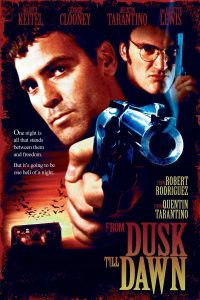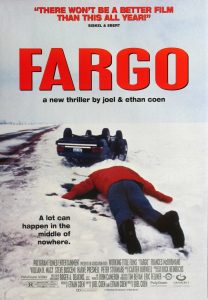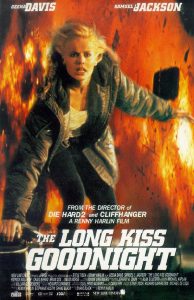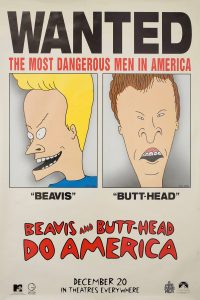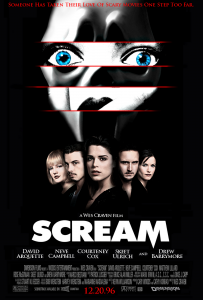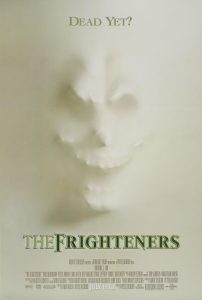1996: The Dream of the Nineties In Film
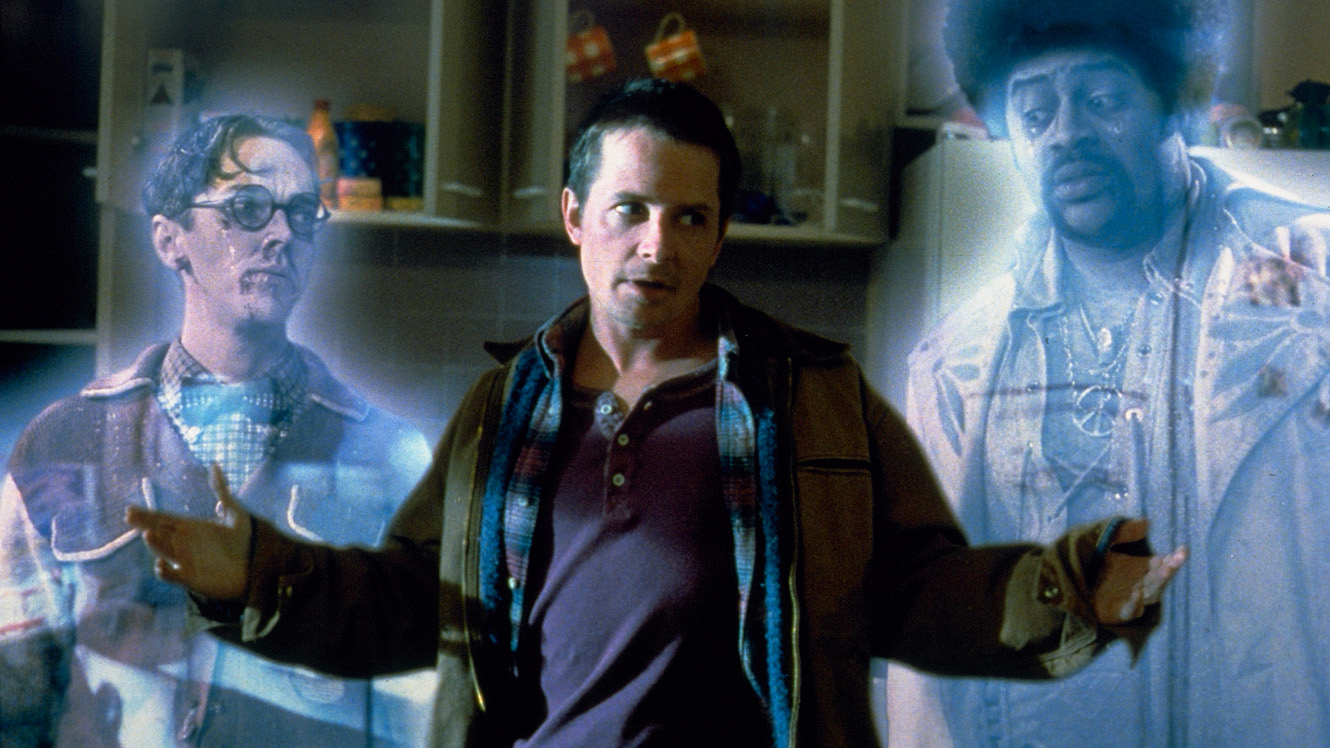
Graduation
For as busy as 1995 was, 1996 was a noted cooldown. There’s fewer movies that made impressions at this point. I’m not sure if it was the fact that I graduated high school, got into a longer-than-usual relationship, started working a regular job, or some other influence. Regardless of cause, this year had fewer entries than I thought it would. What the year does have a bit more of are movies that got watched that year. Timely watching seemed scattershot on previous years. There were films that didn’t get watched until late, but mostly in the next year as I got a job at the local Blockbuster Video with my own membership card.
But enough of that, let’s start with…
The Schlock
From Dusk Till Dawn
When I Saw It: 1996
What It Taught Me: Inappropriate Movie Behavior
Rating: ★ ★ ★
Two hardened criminals on the lam take Harvey Keitel and his family hostage in an attempt to smuggle them over the US-Mexico border in order to lose the Texas Rangers and Feds tailing them. Once in Mexico, they decide to lay low in a place their contact suggests – a seedy bar called the Titty Twister. Once they get there, they find out that the bar is home to a lair of vampires with a hearty appetite for carnage. The only way for the robbers to get to their payday and the hostages their release is to try to survive until sun up.
The best thing about this film was seeing it with my friend, Jimmy. We settled in for a matinee showing at the local-ish theater, waiting for all of the crazy vampire shit to happen. We get to the scene where Selma Hayek is doing her big striptease. When she morphed into her vampiric visage… Jimmy flipped his shit.
He didn’t know!
As it turns out, Jimmy went into this film blind, expecting stock Quentin Tarantino stuff. He hadn’t a clue that vampires were even a factor. After that moment, we all went a little nuts in excitement because Jimmy was now super into the film.
The bonus part of the film experience was when Harvey Keitel blesses a bunch of condoms filled with water. As noted above, we were all really wound up by this point, and I shouted “Start throwing those rubbers!” which in turn caused the rest of the gang to act up even more and probably pissed off some other viewers. It was mostly our group in the theater though (who sees a horror movie at a matinee?) so I suppose it was all in good fun.
I’d have been pissed at me now.
Happy Gilmore
When I Saw It: 1996
What It Taught Me: Absurdity
Rating: ★ ★ ★
A washed up hockey player with a penchant for mayhem faces financial difficulty after his grandmother is put in a nursing home. It’s the shittiest kind, with abusive and apathetic staff because he can’t afford something better for her. In an attempt to make enough scratch to get her moved someplace nicer, he looks to transfer his hockey skills to a high-class, money fueled game: golf. Eventually, he finds himself with a coach, a lady, and a shot at winning one of the most prestigious payouts in the sport. This is provided that he can overcome his anger issues and the smug current champ, Shooter McGavin.
For me, golf is its own joke. Have you looked at it? The pants in specific? It’s basically an excuse for men to go out into a field, drink, and avoid life for four hours while trying to put a small ball in a small hole in a large field. It’s all kind of absurd.
I know – come down off your high horse, you say. I know golf requires skill, I know it requires finesse. I know you have to be strong and smart. It just… doesn’t transfer to the screen for me (and there’s no way in hell I’m watching golf live). I’ve gone over this before. I don’t see all of that nuance. I see old, rich men in stupid pants. Usually drunk. I worked in a country club grill as a busboy that year, so I would know.
Now, add peak Adam Sandler to subvert it, thereby making it even more surreal. Hilarity ensues. This was probably my most watched comedy behind Clerks at the time. I’ve not watched it for many years at this point, but now I feel like I owe it to myself.
Somewhere In the Middle
The Birdcage
When I Saw It: 1996
What It Taught Me: Living La Vida Drag Queen
Rating: ★ ★ ★
Robin Williams and Nathan Lane are two gay men living in Miami above their nightclub, the Birdcage. Before Robin Williams came out, he was married, and he fathered a son who thinks the world of him. When his son shows up to announce he’s getting married, things get complicated. His fiancee is the daughter of a conservative Republican congressman, and a fierce defender of ‘family values.’ Together, father and son try to hide Williams’s and Lane’s sexual orientation just long enough to get to the altar. Things… go sideways in a manner only Lane and Williams can pull off.
By this point, I was familiar with the concept of homosexuality, though I had few direct interactions with actual homosexuals. We had a single girl who came out publicly in my high school class, but… I didn’t really meet anymore gay people (that were open about it) until I went to college. My folks had taught me there wasn’t anything wrong with non-heterosexual people, that there was nothing to be freaked out about. They’re right. But, there’s also a culture there that I think they still might have been a little hesitant to watch with their son in the room (ah, Protestant anxiety). Regardless, we watched this on video that year and it’s pretty good. It has a lot of range. Some would categorize this film as a comedy. There’s a lot to back that claim up given the two leading men. But there’s a lot of good drama in here too, which is the category I’d place this film in.
Fargo
When I Saw It: Circa 1997
What It Taught Me: Not a Comedy
Rating: ★ ★ ★ ★
A lot can go on in relatively small, out of the way towns. Fargo, North Dakota is not an exception, and a lot of things go terribly wrong there in the runtime of this film. It centers around a husband (William H. Macy) who looks to kidnap his wife so he can fleece his father-in-law out of a lot of money. This ends up going fantastically off track when he hires two less-than-stunning career criminals to help him with the heavy lifting. It’s up to the town’s pregnant sheriff to find out what’s going on. Bodies end up on the side of the road, and, eventually, Steve Buscemi ends up going into a wood chipper.
The film made its way to my attention during my time working at the video store. My friends had focused on the comedic aspects of it. They furthermore told me that it was must see, so when the video came off the new releases shelf, I rented it… and presented it to my parents as a comedy.
This, uh… this is not a comedy. It’s the Coen Brothers. If i had known anything about them, I would have known better. I wouldn’t really become cognizant of them or their reputation until 2000 when I saw a film archetypical of their standard modus operandi in an art history class (Blood Simple, 1984).
A fun, family afternoon was thus kind of ruined on account of my not setting the right expectations. It is memorable if nothing else for that.
So… Sorry, mom.
The Arrival
When I Saw It: 1996
What It Taught Me: Crazy and Implausible Technology
Rating: ★ ★ ★ ★
Two people discover that the Earth has been visited by an alien species. The visitors however are angling to become natives by upping the overall climate and altering the mixture of gasses in our atmosphere until it feels like home – and will kill all human life. The pair of heroes are targeted by being disgraced, blacklisted, divested of equipment, and ultimately by becoming the focus of an all out manhunt by the aliens in a cover-up effort.
This was before we all got to find out that Charlie Sheen is batshit crazy. He’s surprisingly reserved in this little-acclaimed film. I really remember being taken with it, but I don’t think it had a very good legacy. This is partially on account of alien saturation in film and television (see last article), but also by its direct-to-video sequel which failed to get the budget, stars, or writers to do anything else other than go for a par-for-the-course cash grab by Artisan Entertainment.
The thing I absolutely loved from this was the idea of the singularity bomb. The aliens had this gizmo that they could throw into a room in order to create a timed, minuscule black hole. It could swallow equipment, evidence, people, you name it, within a localized space, leaving no trace behind. Sure, there’s some problems with this conceptual device (like the whole of physics) but it was still pretty boss at the time.
Dragonheart
When I Saw It: 1996
What It Taught Me: Dragons Can Be Heroes
Rating: ★ ★ ★
After an insurrection topples a tyrant, the ruler’s son is grievously wounded. A knight to the tyrannical King makes a bargain with a dragon to save his lord’s prince whom he is sworn to protect. The boy receives half of the dragon’s heart under the caveat that the kid grows up to not be a dick like his dad. It turns out, the prince is an even bigger douchebag than his father, and he starts really screwing things up in the fief, giving the knight the impression the dragon’s heart was to blame. The knight vows vengeance against all dragons. After several years, the prince has become king, and the knight has gone on to become the best goddamned dragonslayer the world has ever seen. On a hunt for a dragon sighted in the area, he corners the beast only to discover some good news and some bad news. There sure is a dragon around – that is the good news. The bad news is that the dragon reveals to the slayer that he is the last of his kind. No more dragons.… no more dragonslaying. They manage to not kill each other long enough to develop a kind of a con since the knight doesn’t want to be out of work. They team up and begin a hustle in which the dragon shows up, does a little damage, and the knight shows up to ‘kill’ the dragon. This works well until they run afoul of the shithead prince once more and must team up to save the fief.
This film catches a lot of flak. I get the impression from most of my friends that this movie was bad, but… I don’t remember it that way. It’s got Douglas Quaid as Bowen the slayer, and (even better) it has Pete Postlethwaite as a bard following Bowen around (mostly unasked for) to chronicle his deeds. As noted before in 1992, there is nothing Pete Postlethwaite is in that he does not make at least a little better (even Alien 3 (1992).
This film did manage a little something to tweak my expectations. Up to this point, dragons were bad guys. Tolkien, Shadowrun, Dungeons and Dragons – all of those sources made dragons out to be villains, be it the calculating or simply feral kind. I mean, yeah, there was Puff, but… c’mon, he hardly counts given how dopey (and possibly high) he is. This turned that expectation for me, personally. Humans are, after all, the real monsters most of the time.
Independence Day
When I Saw It: 1996
What It Taught Me: Effects Aren’t Everything
Rating: ★ ★ ★
A mysterious signal appears among our satellites as a strange fleet of alien ships descend into our atmosphere. They hover over our largest populations centers as humanity clammers to determine why the visitors have arrived without any kind of warning. A few hours later, the signal stops and the extermination begins. Humanity unites together on the Fourth of July to defend the Planet and scourge the alien armada from our home.
This had too many big names and too much budget to go into the Schlock bucket. But, it’s close. Taking a page from the Michael Bay playbook, this film is mostly about special effects and explosions. I mean, it’s not really a big reach insofar as big summer action movies go. I remember loving it at the time. Because most hormone fueled boys are easily impressed, especially if you put them in a dark place with a girl. I think the girl I was dating at the time went to see this twice with me actually.
The film aged poorly however, and it didn’t take long. I remember being blown away by the visuals in the theater, then watching it in my apartment on VHS a couple months later. What worked on the big screen for some reason does not work on television. The effects were no longer seamless, and the whole thing seemed… cheaper. I don’t know if it was lost in conversion or if I really was just too easily impressed at that age. Maybe it was because at that time I was learning how to do the behind the scenes effect stuff.
The Long Kiss Goodnight
When I Saw It: Circa 1998
What It Taught Me: Samuel L. Jackson Cannot Be Killed; New Jersey Is Hard To Get Out Of
Rating: ★ ★ ★ ★
Gena Davis plays a woman living a happy but ordinary life. She has a husband, a child, a decent job as a teacher. She also has amnesia. She was found on a beach a few years back, pregnant, with no memory of how she got there. She’d all but given up on untangling the mystery of her old life when suddenly she begins to do things she can’t explain after a car accident. The publicity from the accident gains the attention of her former life’s acquaintances. They are not nice people. Turns out, Geena Davis wasn’t a nice person either, but now that she has a child and a husband in her life, she decides to get as far from them as possible before they get hurt. She gets tangled up with Samuel L. Jackson along the way. They go on the offensive to take out her former associates. Sam Jack swears a lot.
This was an unusual find for me. This is pretty action trope heavy – not usually a good sign. The hero with amnesia finds out she was a super spy and denounces their life of wickedness. Pretty hackneyed plot. But, it’s really good. I swear. It was really surprising seeing Gena Davis in an action role for me, and Samuel L. Jackson is absolutely great working alongside her (or did she work alongside Samuel L. Jackson – food for thought).
There were two scenes which really endeared the film to me. One reflects on the difficulty of escaping New Jersey, the other is a battle cry.
Beavis and Butt-Head Do America
When I Saw It: 1996
What It Taught Me: Absolutely Nothing, But I Still Liked It Quite A Bit
Rating: ★ ★ ★
The dim-witted duo from the hit MTV cartoon, Beavis and Butt-Head, come to the big screen! After their idiotic behavior gets them tangled up with a pair of criminals, they go on a series of misadventures through America. Beavis is once again allowed to say the F-word (and by that, I mean Fire) and many immature sexual references are made.
I’m sorry, but there’s something about these two morons that is soothing to the soul. You get the bonus of not having to think very hard to be amused, and additionally you get to see stupid behavior rewarded with the two often times getting exactly what they deserve.
They also take part in the classic fool’s journey. They wander in and out of trouble largely without ultimate consequence, yet failing to really learn anything. You know, like Congress. God bless America. Huh huh huh huh.
Personal Blockbusters
Primal Fear
When I Saw It: 1996
What It Taught Me: Edward Norton Is an Awesome Actor
Rating: ★ ★ ★ ★ ★
In this psychological thriller, a hot shot lawyer takes on a murder case. The client is an emotionally damaged altar boy accused of the killing of a publicly beloved Catholic Archbishop. The lawyer discovers the case is very complicated, and things get much more interesting when the kid sprouts multiple personalities and brazenly admits to killing the archbishop. Sensing that this is just what he needs to get the kid off charges, he pursues it, but finds out that things are not exactly right.
This really sounds straight forward. Shouldn’t be anything to write home about. Then, you get the performance that made me sit up and remember Edward Norton, who plays the altar boy. He’s just a kid in this film. But holy hell does he deliver. I remember this film chilling me down to my toes. It made me a life long Norton fan. To this day, I’m willing to give any film he does a fair shake. Even The Italian Job (2003), which I still haven’t got around to yet.
Romeo + Juliet
When I Saw It: 1996
What It Taught Me: Sometimes Updates Can Be Good
Rating: ★ ★ ★ ★ ★
Do I need a synopsis for this? Okay, here’s the sum up of the Bard’s classic tale: Boy meets Girl. Girl loves boy, and boy feels likewise. They want to get it on, but their families hate each other. They get married in secret, bad shit happens, and boy gets exiled. Priest meets girl, cooks up desperate scheme in which love might conquer all. Plan goes bad. Boy and girl die. Families grieve and rethink their blood feud. Maybe.
Oh, and the Shakespearean classic is ported to a modern setting. The dialog is chopped up and moved around, but mostly in the intended language style. Kind of.
This was a movie that arrived in an odd and fortuitous moment in which two things intersected. First, I had some Shakespeare under my belt (I didn’t go to public school for nothing), so, like some moody teenagers, I developed a thing for this particular story. Second, I actually had a girlfriend that I’d been seeing for a while by this point. Romance wasn’t a theme I investigated until then because I was pretty sure it wasn’t going to be in the cards for me after an earlier dating disaster. But, it felt like I was in love then (I wasn’t), so the movie had a little more charge in it for me.
I also had to toggle my opinion of Leonardo DiCaprio on this film. He does a solid job here as Romeo and is backed up by a great cast between John Leguizamo (Tybalt), Harold Perrineau (Mercutio – favorite role), and Pete Postlethwaite (the Priest) again! It was a good couple years for Pete in the nineties, I guess. The It Girl of the time, Claire Danes, also helped in the leading role of Juliet Capulet. Most of the young men in the nineties probably had a thing for her, and I was no exception.
As a final observation, I am not always hip to updated classics. Sometimes it works better than you’d expect, though. This was an example of when it really works. You see modern ads with antiquated language, guns named after swords, corporate logos for both Montagues and Capulets, and gangs that froth at the mouth with some vengeful sounding cries and taunts. Good stuff if over the top.
Dear God
When I Saw It: Circa 1997
What It Taught Me: It Doesn’t Take a God
Rating: ★ ★ ★ ★ ★
Con man Tom Turner (Greg Kinnear) gets sentenced in court to find legit work within one year. If he cannot keep that job for an additional year and cannot keep his nose clean in that time, he will go to jail. Eventually, Tom settles on postal work in the Dead Letter Office (DLO), believing it to be a great way to continue some side hustles. People mail valuable stuff all the time that gets lost, so it’s like a free grab bag. Tom starts opening letters for profit while posing as a model citizen. In the process, he finds a dead letter – addressed to god – in which a man declares he’s going to throw himself into the ocean to end it all. Tom comes clean to his assembled misfits (the DLO is apparently the dumping ground of the post office per his fellows) and they avert the man’s suicide after deducing a couple of clues from the text of the letter and its postal stamp. Feeling a rush off of doing something so good, they all start addressing the issues from more letters to god. Eventually they get caught and charged with mail tampering and the con man turned savior must defend himself in court.
This is not a film I’d expected to love as much as I did. I’m pretty sure this was an impulse rental – nobody at the store vouched for it. It went to the box office and completely tanked, and reviewers aren’t kind to it. I’m not really a big fan of Greg Kinnear either. The film’s pedigree is low. But, it pleasantly surprised me. For as much flak as it gets, critically speaking, anyone I mention the film to typically has a favorable view on it.
There are three scenes in particular that I love. The first is Kinnear’s first time around in court. The judge is played by a character actor we can all identify, but not by name (his name is Larry Miller and you can find his IMDB entry here). And, man does Miller sell it. After Kinnear tries to con the judge on the bench, he’s asked to approach and Miller spout this great bit about how he’s never had anyone with balls big enough to try to con a judge on the bench. I wish I could find a clip of this, but the internet doesn’t seem to care about this film. I recommend watching the whole movie just to see it.
The second is the scene where Dooley (played by Tim Conway) relates the tale of how he got dumped in the DLO by actually biting a dog.
The last was a throwaway line when Vladek (Hector Elizondo) is taking Kinnear through the post office on an orientation and points to a bright purple machine that looks like a kids slide:
Vladek: This is Barney Machine. You know why we call it Barney Machine?
Tom: Um. Because it’s big and purple?
Vladek: You’ve been here before?
And lastly, this mixes a redemption story with a personal outlook. The redemption story is easy – everyone likes those because we’re mostly wired that way as human beings. We like seeing the good rise up from someone who once was not. But the bigger thing is that it shows people doing good deeds on behalf of an unresponsive god. I am on the fence about sky fathers, benevolent creators, and punishers of the wicked on a cosmic scale. I’d like to believe – but, it would be a tremendous relief to just know. I lack faith in the theological arena. It may seem bleak, but it appears to me that if there is a god, it is highly likely that it is indifferent to us at best (in fact, it may even be Durden-esque per Fight Club (1999). So, when people take up the reins of that indifferent watcher in the sky and start assisting the people doing the god-asking… that feels good. People taking responsibility for each other is uplifting. It feels just in a concrete way that ‘giving it up to god’ does not.
Even if it is super illegal how they go about it.
Scream
When I Saw It: 1996
What It Taught Me: Horror Tropes and Lots of Them; Kill the Headliner
Rating: ★ ★ ★ ★ ★
A small town is plagued by a series of brutal murders. The victims are mostly young high school kids, and the police are baffled. This all has one teenage girl, Sidney (Neve Campbell), particularly freaked out. Her mother was murdered a year ago; the new killings seem to have some similarities. Rumors fly, and the kids get to making suppositions about how it all feels like it’s a horror movie. Horror movies have rules, right? And if you follow them, you won’t get killed by some serial slasher, right? Well… maybe, maybe not. The film gets increasingly meta the further it goes, and ramps up to a conclusion that is predictable, yet wholly engaging.
Horror was starting to get a more steady repertoire in my viewing diet by this point. While I went in (and still do) for less-is-more style films like The Haunting (1963), or Stir of Echoes (1999), I had (and still do) a general lack of one of the more popular horror sub-genres: slasher films. This is a lampoon of that sub-genre, and it more or less gave me the template for the it without really having to hit any other works. I still have seen zero Jason or Freddy movies, and have seen only a single Halloween film (the original Halloween (1978), which… left me with a flat impression. Slasher flicks aren’t my thing, but this was different and very tongue-in-cheek.
This really got a second sub-genre going: Meta-horror. In this film type, the characters are just short of realizing they are actually in a horror film. They recognize horror tropes and either try to follow them to survival, or subvert them enough to make things interesting. It’s kind of fascinating – but it can wear off quickly.
It’s arguable that the film’s biggest shocker was the decision to kill off Drew Barrymore – one of the headlining performers – within the first ten minutes of the film. She’s a big name who’d you’d expect to get plenty of screen time given how much it costs to hire her. But if there’s one thing we know about Wes Craven, it is that he does not give a good goddamn about what you expect.
The Frighteners
When I Saw It: 1996
What It Taught Me: How to Build an Underworld; You Can’t Keep a Good Canadian Down
Rating: ★ ★ ★ ★ ★
Frank Banister is a con man with a unique hustle. He styles himself as a paranormal investigator, which is half true. He’s not much of an investigator, but he can see and interact with the spirits of the departed after experiencing a near-death encounter in a car accident that he – but not his wife – survived. He has four ghosts that he uses to stage hauntings which he then conveniently shows up to solve. Together with his band of ghosts, he manages to hustle successfully until a particularly nasty spirit, the Soul Collector, begins to kill with great frequency, laying suspicion on Frank for his spectral crimes. Beyond that, the malevolent spirit’s activities reopen Frank’s old wounds and personal secrets as the story advances toward grim and shadowed paths.
This is a film I feel is vastly underrated. Of course, I love ghost stories. It’s not a stretch that this was my best film for 1996. I really liked the internal logic of the way spirits worked. Some were weak, some were strong. There was an implied social structure enforced by cemetery guardians. It meshed well, it was consistent, and more importantly it was entertaining.
The truly amazing thing though was the change of tone as the film progresses. It starts slow and light-hearted. Sure there’s dead people involved, but they provide comedic relief and everything sets up as wacky and a little off color. By the time you reach the end, the film is now stark and ominous. There is evil in the region that is manifest. That evil is determined, ruthless, and calculating. The Frightners starts out comedy, but ends up horror.
As a point of interest, Michael J. Fox plays the lead (Frank Banister) and did so just after announcing that he had Parkinson’s Disease the year prior. Turns out he’d known since Doc Hollywood and it wrecked him for a while. It was a big thing during the filming, as it showed that Fox wasn’t about to let the disease keep him down.
